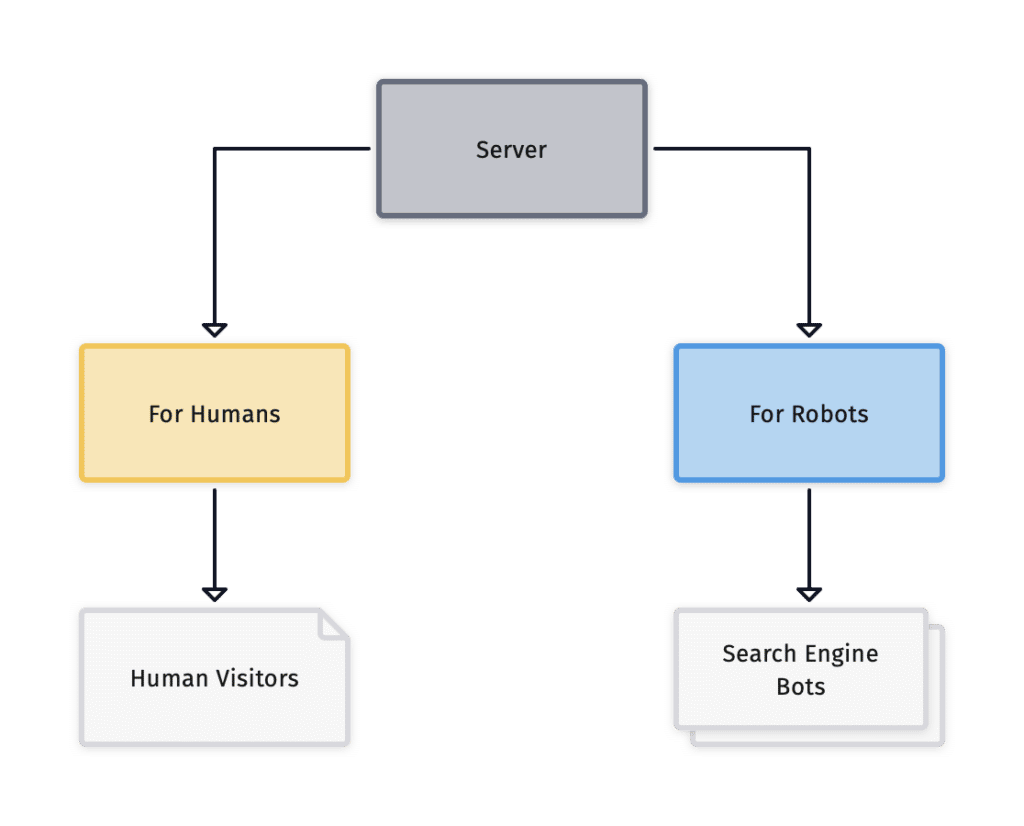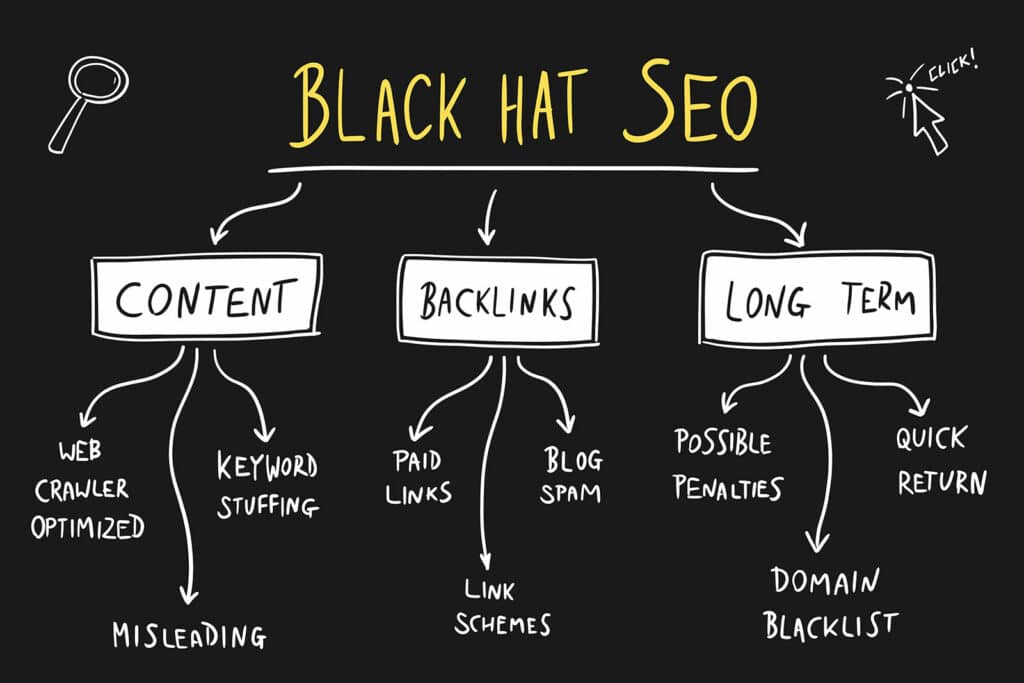Cloaking in SEO is a black hat technique in which a website displays a distinct URL or content to visitors and another to Google search crawlers such as search engine bots. This is an effort to fool search engines to boost the website’s ranking in SERPs.

In other words, cloaking displays various web page versions to distinct audiences. It deceives search engine algorithms into ranking a website higher.
Cloaking aims to offer distinct and sometimes irrelevant or low-quality information to actual human users while tricking search engines into believing that a website has excellent content for a particular search query. This is forbidden by search engines like Google and is regarded as a black hat SEO tactic.
Table of Contents
What are the Different Types of Cloaking?
There are five main types of SEO cloaking that can be performed on a particular website. Understanding these various types can help you better solidify your characterization of cloaking.

1. User-Agent Cloaking
You’ll use a web browser to access the general information you want online. Once pulling up the web browser, you’ll type in the search query of what you’re looking for. Your web browser will then send a code to the website you’re trying to visit.
The website can identify if the code is from a website crawler or a user like you. If a website determines that a search engine crawler is attempting to access its web content, it will send the cloaked version of the website.
2. IP Cloaking
Every device that you have which connects to the Internet will have its own unique IP address. This IP address is based on your internet provider and location. IP-based cloaking is a black hat SEO technique that involves recognizing the IPs of the search engine crawlers.
Whenever one of these IPs is recognized, a false website is shown. In many cases, the false site will have more keywords that help boost the website’s ranking in the search engines. This allows a website owner to make their site more user-focused without the need for optimizing their actual user-displayed page for the search engines.
3. JavaScript Cloaking
This black hat SEO cloaking method splits website visitors into two parties. The first is those that have JavaScript disabled, which is typically the search engines. They’ll be given a widely optimized website that is more geared towards ranking on the first page of Google.
The second group is those who have JavaScript enabled. Regular website visitors who receive the user-friendly version of a website fall into this category.

4. HTTP_REFERER Cloaking
This method of website cloaking involves checking the visitor’s HTTP_REFERER header. A fake page is generated with optimized content when the header is identified as coming from a search engine crawler. A user-optimized website version is displayed when the header isn’t a known search engine crawler.
5. HTTP Accept-Language Header Cloaking
Similar to the previous cloaking method, this technique looks at the visitor’s HTTP Accept-Language header. If the header is known to be from a search engine, then an SEO-optimized website is displayed. The user-optimized website is displayed if it’s not from a known search engine.
What are Some of the Most Common Methods for Cloaking?
Now that you understand the various types of SEO cloaking that can be performed, it’s time to see how it’s implemented. There are four common methods used to enact these various cloaking types.
1. Using Hidden Text
One very simple method for cloaking is to include hidden SEO optimization text. Hiding the text involves setting it to the same color as the website background. This way, the text is still technically on the website. However, it’s not visible to the human eye. Only search engine crawlers can read the hidden text.
White text code Cloaking example:
<p style="color:#FFFFFF">Your text here</p>2. Flash-Based Websites
This cloaking method involves creating a simple HTML website page that is ideally optimized for search engines. Then, additional flash pages with user-friendly content are shown to website visitors.
It is commonly known that SEO recommendations do not advise Flash. However, because many websites have built-in Flash or require many flashes, they cannot avoid it. They develop content-rich web pages and supply them to search engine crawlers and flash pages for visitors rather than rebuilding websites and rewriting everything in plain HTML.
3. HTML Rich Websites
It is advised that your web page have the highest “TEXT to HTML ratio” possible. The page should have more text (content) than HTML tags. Writing a brief article or post, on the other hand, will result in a low text-to-HTML ratio. Cloaking is used to fulfill SEO requirements rather than reaching the optimum text-to-HTML ratio of 25-70%.
4. Replacement of Java Scripts
JavaScripts are used in cloaking tactics to make visitors see content that is different from what is actually on the page. This entails displaying material that is not visible to search engines using other markup languages such as HTML. It employs a script that detects the user’s IP address and then serves relevant material based on the user’s location or based on the user’s browser type. This is frequently done to improve the user experience while optimizing the site for search engines.
What is Google’s Penalty for Cloaking?
Every website owner wants their website to appear at the top of the search results for terms relevant to their industry. The more traffic a website receives, the more customers it will likely gain. Unfortunately, meeting the specific search engine requirements isn’t easy in a user-friendly website version. This is why cloaking has developed as an easy-to-use method to deal with the rigorous demands of search engines.
SEO cloaking includes unethical practices such as hidden scripts, texts, and links by using Javascript and CSS. Cloaking in SEO is a deliberate attempt to trick crawl bots and a significant violation of search engine guidelines, including Google’s Webmaster Guidelines, when done on purpose and will result in a Google Penalty. A Google Penalty will cause a dramatic decline in ranks, resulting in less visibility, engagement, and conversions.

Does Black Hat Cloaking Still Work?
The simple answer is that it depends. Some cloaking methods, like hidden text, need to be updated and won’t work anymore. Even IP-based cloaking has been phased out as the simple solution of using a proxy for the search engine crawler has shied many away from the idea of this cloaking method as being effective.
In reality, cloaking is only a short-term solution to enhance your website’s search engine ranking. As talks of new cloaking methods are discussed online, search engine researchers identify the new methods and develop a defense for detecting dishonest cloaking. As long as search engines are around, they’ll always have research teams working on handling new cloaking measures. It’s only a matter of time until each method is counter-measured by the search engines.
What to Do Instead
Cloaking isn’t a long-term method for ranking a website, so if you’re implementing a cloaking strategy, you may want to undo the modifications and avoid penalization before Google discovers the trick. Those found violating their set standards will be blocklisted. This means the website will no longer appear in search engines for any terms.
Instead, focus on fixing the issue you’re trying to remedy with cloaking. For example, if you have too many HTML tags compared to the amount of text content on your web pages, then add more text. Sure, it will take a bit longer and may cost more money. But, you can significantly reduce your website’s risk of being blocklisted and investing your time and money into a website that no longer makes you money.
Cloaking should be excluded from your SEO strategy plan. Instead, marketers should concentrate on white hat SEO strategies to rank high on SERPs, such as developing high-quality content, sharing it on social media platforms to increase brand awareness and credibility, using inbound marketing, and internal and external link development.
How SEO North Can Help
SEO North provides complete SEO services in Ottawa, Canada, to assist businesses in increasing their online presence and achieving long-term success. To optimize websites for higher positions on search engine results pages, our experienced team solely employs white hat SEO strategies. SEO North is here to assist if you want to improve your digital marketing approach! If you want to stay ahead of the SEO competition, email or call us today!
FAQ
What is cloaking in SEO?
Why cloaking is done?
How do you know if a website is cloaking?
Which techniques is an example of black hat SEO cloaking?
What does black hat mean in SEO?
Is SEO illegal?
Published on: 2022-09-06
Updated on: 2023-07-12